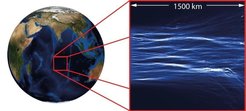Small ripples in the ocean floor focus tsunami waves
Tsunamis are among the most devastating natural disasters. Even though the seaquakes which cause most tsunamis are still unpredictable, there often exists a span of time between the excitation of a tsunami and the moment when it hits the shore and causes destruction. This precious timespan can be used for tsunami warning systems. Their reliability, of course, hinges on the accuracy with which one can computationally predict tsunami propagation. In their Nature Physics publication "Random focusing of tsunami waves", researchers from the Max Planck Institute for Dynamics and Self-Organization (MPIDS) in Göttingen have now shown that this accuracy is very sensitive to the precision of the available data for the height profile of the ocean floor.
Electron waves propagating through a very pure semiconductor are only slightly deflected from their straight path by weak disorder in the crystal. When observing the density of the corresponding current, however, one sees, surprisingly, strong branch-like spatial structures. Researchers from Göttingen have now demonstrated that the same mechanism that leads to the branching of the electron flow on length scales of micrometers (i.e. thousandths of a millimeter) applies to tsunami waves on scales 1000 billion times larger and leads to pronounced and hard to predict spatial variations in the wave heights.

Where disorder in the crystal produces the branches in the electron current, for tsunamis it is the fluctuations in the ocean floor that cause branching, i.e. the underwater hills and valleys. Single small hills and valleys have almost no influence on the tsunami waves at all. Many of them, however, which are spatially related by the geological processes that once formed them, can easily focus the tsunami energy ten-fold, even if their heights measure only a few percent of the ocean depth (an example is shown in the figure).
Random focusing of tsunami waves makes them harder to predict
„In our study we found that even variations in the ocean floor height that are smaller than the uncertainties in the available global ocean depth data can cause such focusing events. In future, reliable tsunami predictions will therefore need to incorporate this effect and statistically account for the consequences of the uncertainties in the ocean depth for every prediction individually”, says Dr. Ragnar Fleischmann who headed the study at the MPIDS in Göttingen.
